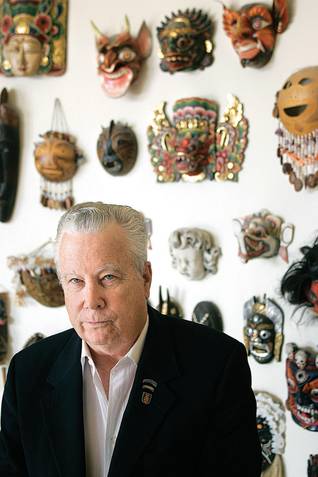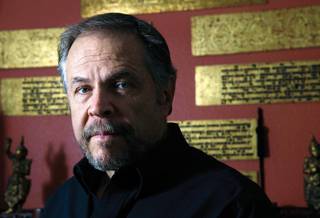
Ret. Col. John Alexander was involved in investigating paranormal phenomena and is the inspiration behind George Clooney’s character in “The Men Who Stare at Goats.”
Thursday, Oct. 22, 2009 | 2 a.m.
Sun Archives
- Hollywood's attention unwelcome (6-15-2009)
Beyond the Sun
The old spies who live among us have their own organization and meet every couple of months at Nellis Air Force Base.
One of the leaders of the group, retired Army Col. John Alexander, was the basis for the George Clooney character in “The Men Who Stare at Goats,” which hits theaters in early November. But each of the 40 or so active members of the Association of Former Intelligence Officers’ Las Vegas chapter could be turned into a film character.
Sully De Fontaine, for example, is a former World War II OSS member who, as a teen, twice jumped behind enemy lines into occupied France to save American fliers who had been shot down and were being hidden by the Maquis, the famed French resistance fighters. De Fontaine is also a first-generation Special Forces, or Green Beret, commander. Sitting with his cane at a recent chapter meeting at Nellis Air Force Base, the 82-year-old had the unflappable look of someone who laughs at bombs tossed his way.
Then there’s 65-year-old Ken Walther, who spent 27 years in the Central Intelligence Agency and described his work as building “all these cool devices, similar to what the ‘Q Branch’ did for (James) Bond.”
In short, Walther was a gadget maker.
One of the more famous capers he worked on involved the creation of devices that looked and acted like bombs, except they couldn’t detonate. CIA operatives gave the devices to Spanish terrorists who in 1983 planned to kill Juan Carlos, the King of Spain. Hidden within the fakes were homing devices that led to the terrorists’ capture.
Walther has lived in Southern Nevada for more than a decade and these days is a businessman working on a “biometric smart card.” The way he describes it, the card will revolutionize the security of credit cards and other magnetic-stripped cards. The cards will work only for the person they are assigned to.
“It will be more accurate in identifying you than a fingerprint,” he said.
He’s also working on a device for detecting volatile gases and radiation for Homeland Security.
He talks excitedly about the work. At the same time, however, he says nothing will compare to what he did in the CIA.
“It was the best thing I could ever think of doing.”
That visceral connection is partly why he and Alexander and others are members of the retired spies group.
Richard Cohn, 54, an Energy Department employee who is president of the Las Vegas chapter, says its gatherings are about “that camaraderie of the former folks getting together and discussing recent events, the history of what they’ve been through, and there are liaison opportunities between former and current folks.”
Meetings in the past year have included presentations about Las Vegas’ Joint Terrorism Task Force, the development of the U-2 and A-12 spy planes at Area 51, and “The Real History of the Civil Air Transport/Air America.”
Nationwide, the Association of Former Intelligence Officers boasts 5,000 members in 23 chapters. Some 200 members from across the country gathered in Las Vegas this month for their national fall symposium, “Cold Warriors in the Desert: From Atomic Blasts to Sonic Booms,” which was co-sponsored by the Energy Department, the National Nuclear Security Administration and the Air Force Warfare Center.
Attendees toured the Nevada Test Site, were briefed on and viewed the remote-controlled Predator/Reaper unmanned plane, and heard about “The Real Spy’s Guide to Becoming a Spy,” by Peter Earnest, former CIA operative and current director of the International Spy Museum in Washington, D.C.
When retired spies from across the nation get together, they can delve into topics that sound a little beyond average folks. Alexander, a frequent presenter in the local chapter, for example, gave a presentation on “Geotransformational Changes that Affect the Future of Conflict.”
Alexander’s Hollywood fame is coming because of his involvement in investigating paranormal phenomena, such as psychokinesis and remote viewing, and their potential use by the Army.
Having been called the “father” of the nonlethal weaponry concept, he remains active in intelligence circles by writing position papers for the Joint Special Operations University and travels the world seeking ways to improve military operations.
A Special Forces commander in Vietnam, the Wisconsin native is white-haired and close to or in his 70s — he won’t tell his exact age. His eyes are almost always narrowed in thought.
The club for former intelligence officers is not for everyone, he said. Some just leave the cloak-and-dagger world behind.
“There are those who, you know, fold their tent and move silently into the night,” he said. “There are others, who say, ‘We kind of miss the action. We’d like to find ways to continue to participate.’ ”
The Las Vegas Valley is dotted with former employees of the Army’s intelligence division, the National Security Agency, the CIA and other so-called “three-letter agencies.”
Some retire here because they worked, or are still employed, nearby — at Nellis Air Force Base, the Nevada Test Site or Area 51, the supersecret research base 90 miles northwest of Las Vegas, to name just a few examples.
Others moved here for the same reason civilian retirees do — for the climate and low taxes.
As a place for intelligence operatives to retire, “Las Vegas appears to be a target-rich environment,” Cohn said.
Some have written books here, but many of them aren’t the kind of people who want their stories told.
Their solitary senses honed by their former lines of work, many of the men and a few women at a Nellis meeting of the Las Vegas chapter this year avoided eye contact with a Sun reporter.
Or maybe that was just the reporter’s interpretation, part of what Alexander sees as the “mythology” of intelligence work promoted by the media.
Sure “the spies you read about are certainly there,” Alexander said. “But that’s a very small percentage of the folks in the intelligence community ... The vast majority of the people involved are analysts and the requirement for linguistic skills is immense.”
To make that point, part of Alexander’s presentation in local high schools includes a picture of a crossed-out James Bond. Intelligence organizations have a “real challenge” getting talented recruits, which is part of the reason the local chapter of the association offers a scholarship to one high-schooler each year.
“Nobody has done very much about figuring out how to convince people to even look at the field,” Alexander said. “But if you like problem-solving, this is the place to give serious consideration.”
For Walther, the excitement will never be matched.
“Living in all the different countries, doing work that figures important — counterterrorism, narcotics, espionage, you name it, anything on the menu at the time, I worked on.
“It was quite the life.”


Join the Discussion:
Check this out for a full explanation of our conversion to the LiveFyre commenting system and instructions on how to sign up for an account.
Full comments policy